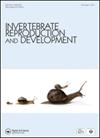Occurrence of male morphotypes in the freshwater prawn Macrobrachium acanthurus Wiegmann, 1836 (Decapoda, Palaemonidae)
IF 0.8
4区 生物学
Q4 REPRODUCTIVE BIOLOGY
引用次数: 3
Abstract
ABSTRACT This study tested the hypothesis of the existence of male morphotypes in Macrobrachium acanthurus, a species of recognized economic potential, with an extensive geographic distribution. The collections occurred on eight occasions between July 2016 and March 2018 at seven points along the Jequitinhonha River, state of Bahia, Brazil. The identification of male morphotypes occurred through morphological and morphometric analyses. In total, 297 males were collected. The carapace length (CL) ranged from 4.6 to 41.81 mm, with a size at onset of maturity estimated at 11.85 mm. The morphological and morphometric analyses confirmed our hypothesis with the distinction of three morphotypes: M1, M2, and M3. M1 was characterized by males with chelipeds similar to those of females: relatively small, with tiny spines and without pubescence in the dactylus; M2 males had chelipeds larger than those of M1, as well as larger and denser spines, with little pubescence in the dactylus; and M3 individuals had considerably more robust chelipeds, very prominent spines and a thick layer of pubescence when compared to those of the previous morphotype. Our results suggest a social hierarchy where M1 is subordinate, M2 subdominant, and M3 the dominant morphotype. However, behavioural studies are needed to confirm this.1836年淡水对虾acanthurmacrobrachium Wiegmann雄性形态的发生(十足目,对虾科)
摘要:本文对棘巨螯虾(Macrobrachium acanthurus)存在雄性形态的假设进行了验证,该物种具有广泛的地理分布,具有公认的经济潜力。2016年7月至2018年3月期间,这些藏品在巴西巴伊亚州Jequitinhonha河沿岸的7个地点共发生了8次。雄性形态型的鉴定是通过形态学和形态计量学分析进行的。总共收集了297只雄性。甲壳长度(CL)在4.6 ~ 41.81 mm之间,成熟时的大小估计为11.85 mm。形态学和形态计量学分析证实了我们的假设,并区分了三种形态:M1, M2和M3。M1的特征是雄性的蹄足与雌性相似:相对较小,具有微小的棘,趾部没有短柔毛;M2雄性的跖骨比M1大,棘也更大、更密,指趾上的短柔毛较少;与前一种形态相比,M3个体具有更强健的蹄足,非常突出的脊柱和厚层短柔毛。我们的研究结果表明,M1是从属的,M2是从属的,M3是主导的形态。然而,需要行为研究来证实这一点。
本文章由计算机程序翻译,如有差异,请以英文原文为准。
求助全文
约1分钟内获得全文
求助全文
来源期刊
CiteScore
1.90
自引率
0.00%
发文量
21
审稿时长
>12 weeks
期刊介绍:
Invertebrate Reproduction & Development ( IRD) presents original research on the reproductive and developmental biology of the Invertebrata, both embryonic and postembryonic. IRD welcomes papers reporting significant results obtained using new techniques. Encouraged topic areas include: aquaculture, physiology, biochemistry, functional morphology, phylogeny, behavioural and regulatory mechanisms, including genetic, endocrine and molecular studies. Papers containing qualitative descriptions of reproductive cycles and gametogenesis will not be considered. IRD is published in association with the International Society of Invertebrate Reproduction and Development.

 求助内容:
求助内容: 应助结果提醒方式:
应助结果提醒方式:


